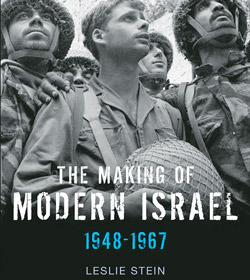In-depth look at Israel’s history
WITH the Middle East peace process unravelling in recent years, Dr Joff Lelliott reviews a book that examines the pivotal events in Israel's history.
The Making of Modern Israel: 1948-1967, by Leslie Stein. Polity Press, $31.70
WITH the Middle East peace process unravelling in recent years, re-examining the pivotal events of 1948 to 1967 is timely.
Many of the issues preventing a final Israeli-Palestinian peace agreement stem from the period covered in Leslie Stein’s new book, The Making of Modern Israel: 1948-1967.
These include the status of East Jerusalem, the 1967 borders and the unique inter-generational inheritance of refugee status for displaced Palestinians.
There is much ground covered in the book, with the War of Independence, the Suez conflict and the Six-Day War, as well as mass immigration, economic developments and relations with the Palestinians included.
Stein’s descriptions of ordinary people’s lives work particularly well. He describes the chaos of processing waves of arrivals in post-independence Israel, with the quick succession of arrivals first from Bulgaria, followed by displaced people from Germany, Austria and Italy, then from Yemen, then Turkey, Poland, Iraq, and finally Romania.
Lighter moments include the story of a group of Israelis in Britain buying heavy bombers, apparently for use in a war film. Once the planes took off, the film crew disappeared and the planes turned up in Israel’s air force.
In a country with few resources or international friends, and hence a limited range of food in the early years, Stein writes people became “sick at the sight of eggplant” and the myriad recipes promoted for it.
But by 1958 Israel was producing 70 per cent of its food compared with 30 per cent at independence.
Using facts like this, Stein shows why Israel survived against the odds. Its founders had the vision and determination to build a strong country -— providing its own food, rejecting calls from some Israelis to curb immigration, building the economy and devoting a whopping nine per cent of early budgets to defence.
The book finishes with the 1967 Six-Day War, which paradoxically increased the area under Israel’s control significantly, while reducing its borders by a third. On the back of this war, Israel had a new-found confidence that it would survive, despite its tumultuous first 20 years.
Stein is visiting fellow in economics at Macquarie University, but has also written Hope Fulfilled: The Rise of Modern Israel and jointly edited Continuity, Commitment and Survival, Jewish Communities in the Jewish Diaspora. He is unashamedly pro-Israel, and at times some readers may feel he is too one-sided.
The book is weakened at some points by an absence of broader political and international developments. In covering the War of Independence, we are not told how the first ceasefire was arrived at, or who was making the military ­decisions.
In his introduction, Stein says he aims to synthesise existing work into a single volume aimed at non-academic readers. What is not said is why we should read this book rather than other works, such as Martin Gilbert’s Israel: A History, aside from the fact that Stein’s book is considerably shorter!
It may well be shorter than Gilbert’s, but Stein probably has more on the way. His first book traced developments from the early days of Zionism to the eve of the War of Independence, so presumably he is writing a final volume taking us from 1967 to today.
Dr Joff Lelliott has a PhD in Jewish studies from University College London and publishes on Middle-Eastern issues.


comments